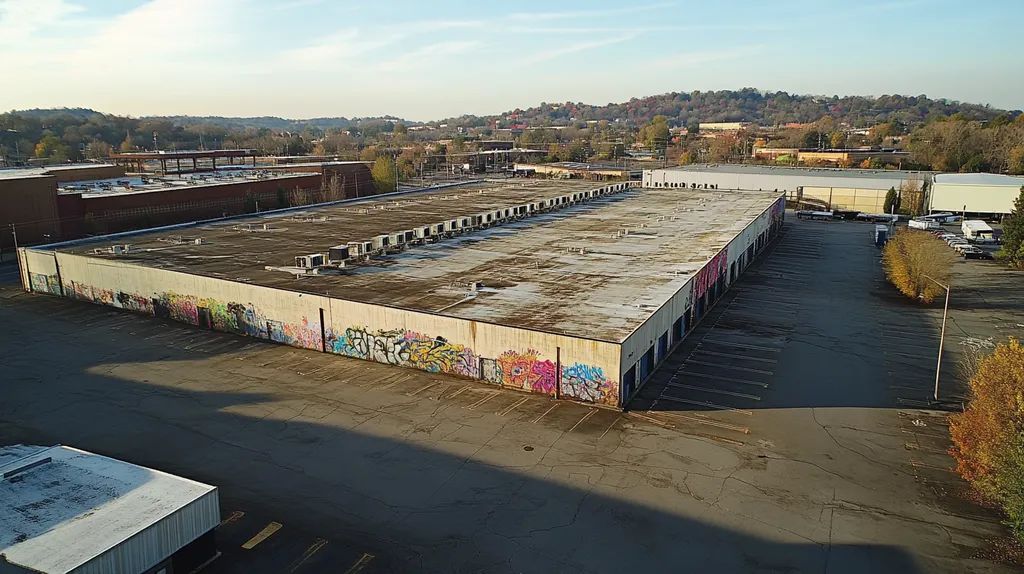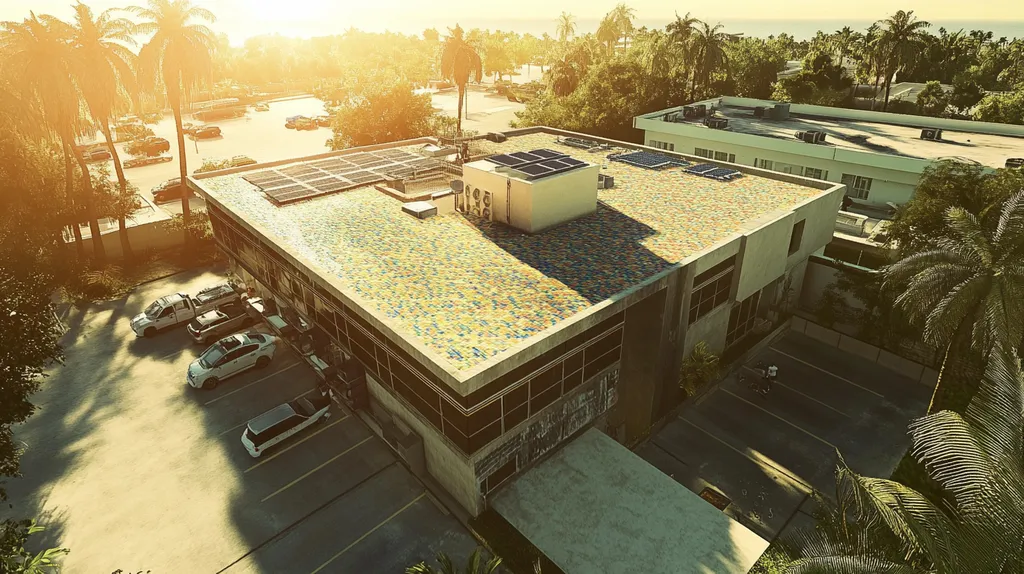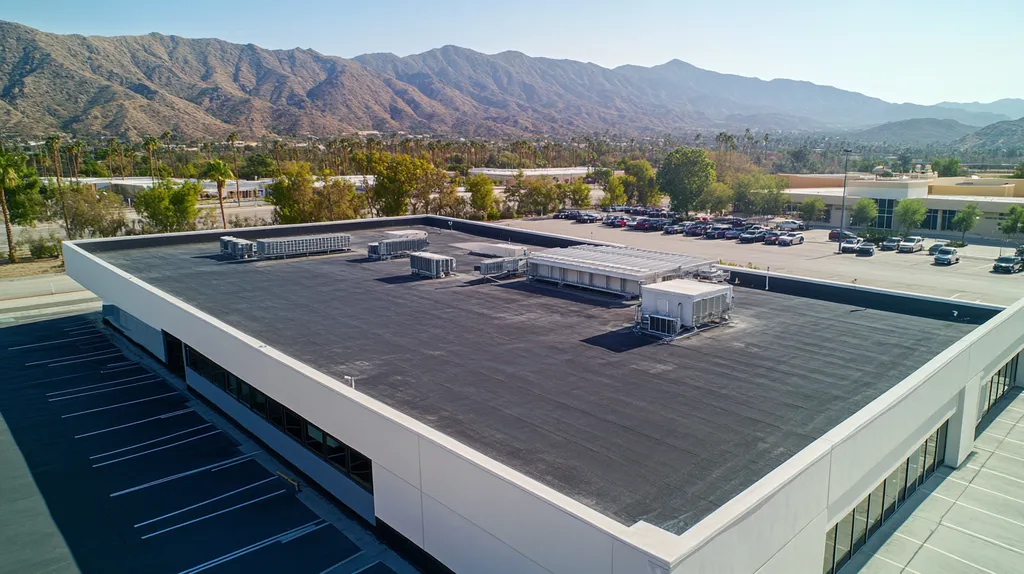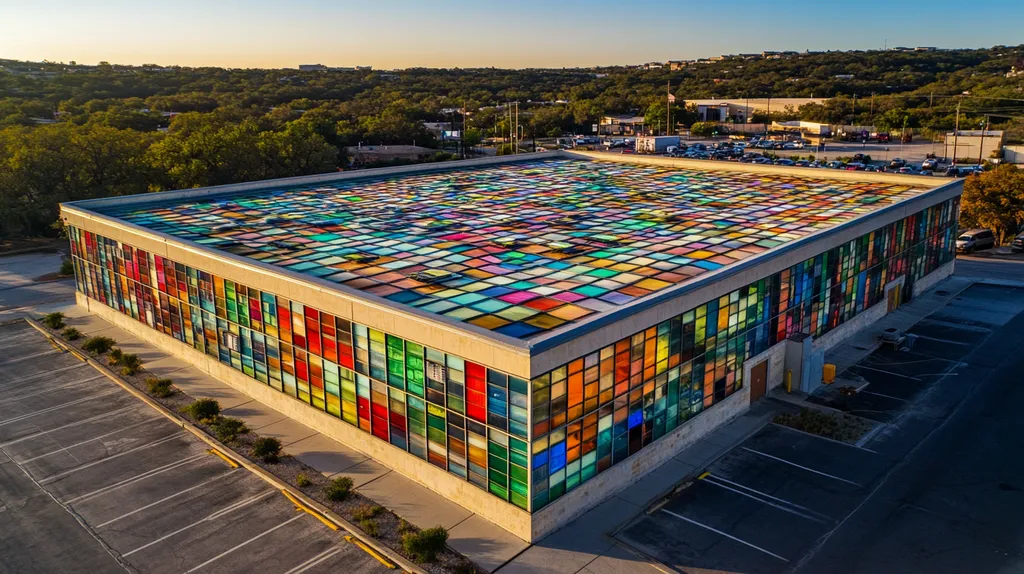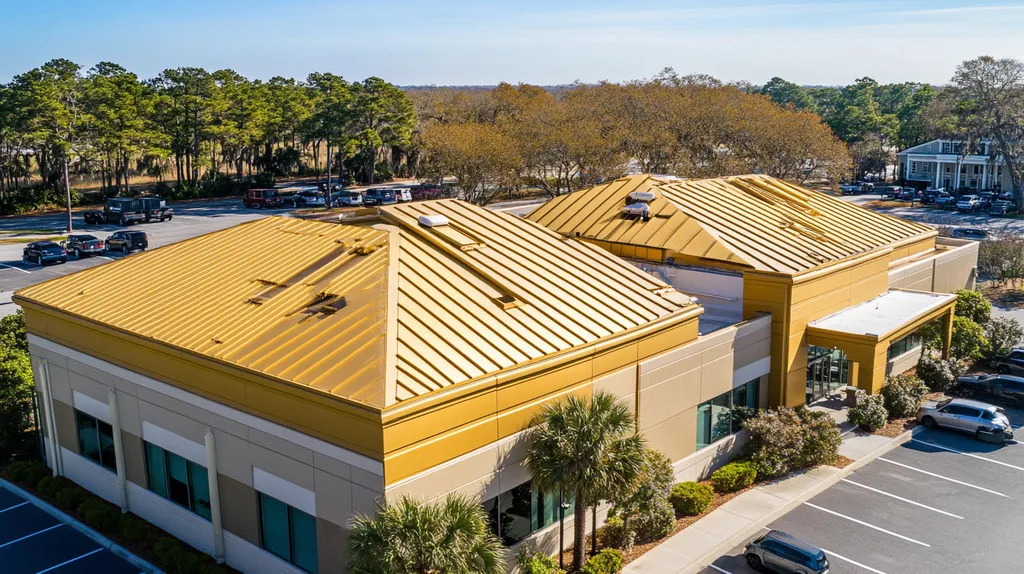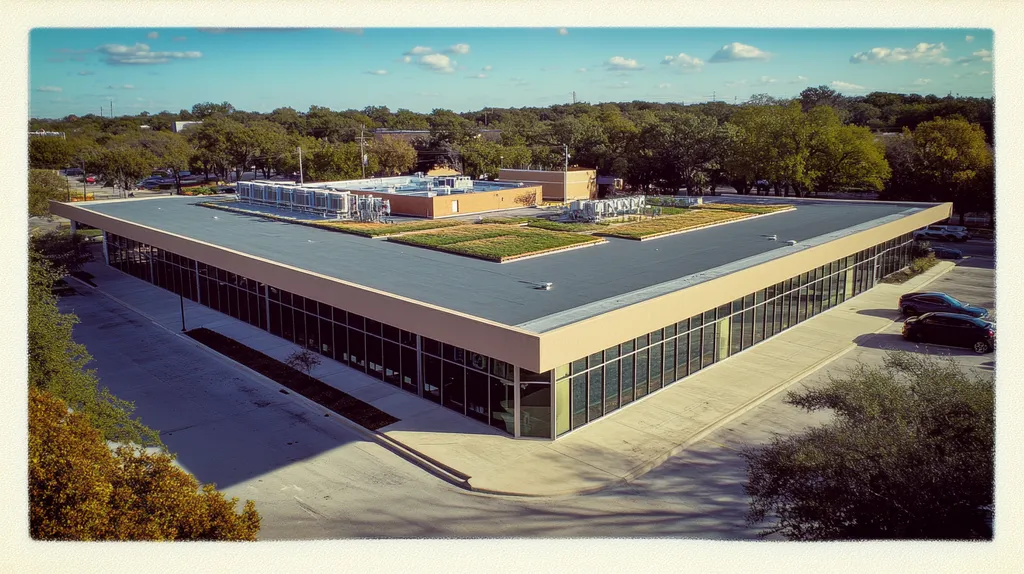As energy costs soar and environmental regulations tighten, commercial property owners face mounting pressure to adopt sustainable roofing solutions. Research shows that buildings waste up to 30% of their energy through poorly maintained or inefficient roofs.
Eco-friendly roof coatings represent a critical solution, offering both environmental benefits and significant cost savings. These innovative materials can reduce cooling costs by up to 25% while extending roof life by 10-15 years.
This comprehensive guide examines how sustainable coating choices impact building performance, maintenance costs, and long-term property value, providing property managers with actionable insights for smarter roofing decisions.
SECTION 1: THE BASICS EXPLAINED
With energy prices steadily climbing and environmental challenges becoming more pressing, the choice of roof coatings for commercial properties has never been more critical. Research from the U.S. Department of Energy highlights that roofing can influence energy usage by as much as 25%. By opting for eco-friendly roof coatings, property owners can effectively shrink their carbon footprints, boost their properties’ market value, and lower their operating expenses. Grasping the fundamentals of these coatings is essential for those tasked with making impactful decisions in property management.
What It Is (In Plain Language)
Eco-friendly roof coatings are advanced materials designed to protect roofs while being kind to the environment. Many of these coatings feature reflective surfaces that bounce sunlight away, leading to cooler roofs and lower cooling costs for buildings. Think of it as giving your roof a sunblock that shields it from heat!
Moreover, eco-friendly coatings often use water-based formulas, contain minimal volatile organic compounds (VOCs), and may incorporate recycled materials. This means fewer harmful chemicals are released into the air, both during application and throughout the life of the product.
Common types of eco-friendly coatings include elastomeric and silicone options. Each type offers unique features tailored to different roofing needs, promoting sustainability while ensuring effective protection. Familiarity with these options can guide property owners in making savvy choices.
In essence, eco-friendly coatings are not just about aesthetics; they provide a sustainable means to enhance the durability and functionality of roofing systems while aligning maintenance practices with environmental priorities.
Why It Matters (To Your Building)
Choosing eco-friendly roof coatings signals a genuine commitment to sustainability, resonating well with today’s consumers and business partners. In an era where corporate responsibility is scrutinized, properties embracing green practices tend to enjoy better reputations, leading to happier tenants and increased occupancy rates.
Additionally, eco-friendly coatings significantly boost a building’s energy efficiency. Lower energy consumption translates into substantial cost savings—some commercial properties adopting reflective coatings report energy savings between 10% and 30%, which can greatly improve profit margins over time.
These green coatings also lengthen the lifespan of roof materials, resulting in fewer repairs and replacements. This reduction not only minimizes expenses but also decreases environmental waste. By investing in sustainable options, property owners support a circular economy that benefits their assets and the planet.
In the grand scheme, the choice of roof coatings holds substantial implications—not only for individual buildings but also for enhancing community sustainability and meeting strict environmental regulations.
How It Works
Eco-friendly roof coatings enhance roofing systems by providing protective barriers against environmental elements, like harmful UV rays, heavy rain, and extreme temperatures. This helps preserve the structural integrity of roofs over time, much like weather-resistant paint protects your home’s exterior.
These coatings often possess reflective properties, which help manage heat buildup. As interior temperatures stabilize, the reliance on air conditioning decreases, leading to lower energy expenses and a more cost-efficient property.
The application process for eco-friendly coatings is often simpler than for traditional materials. Many can be applied over existing roofs without significant preparation, saving time and reducing labor costs.
Moreover, eco-friendly coatings can facilitate better stormwater management. Utilizing innovative materials that promote efficient water runoff, they contribute to more sustainable urban environments, lightly countering the negative effects of impermeable surfaces often found in commercial real estate.
Overall, eco-friendly roof coatings offer a blend of practical benefits, financial savings, and environmental advantages, marking a forward-thinking approach to the challenges faced in today’s roofing landscape.
SECTION 2: PRACTICAL APPLICATIONS
As material costs rise and environmental concerns gain prominence, property owners are increasingly urged to turn toward sustainable roofing solutions. Eco-friendly roof coatings not only represent a wise investment but also provide a crucial response to these industry challenges. By adopting these innovative materials, businesses can improve energy efficiency, extend the lifespan of their roofs, and lower maintenance costs. This section will delve into common applications, ideal scenarios for installation, and the interaction between these coatings and existing roofing systems.
Common Uses & Examples
Eco-friendly roof coatings are becoming essential in various commercial sectors. Businesses are increasingly adopting reflective coatings, which help minimize heat absorption and reduce cooling expenses. For example, a warehouse that applies a white elastomeric roof coating has reported indoor temperature reductions of up to 20%, leading to considerable energy savings.
Waterproofing is another prevalent application; coatings made from materials like silicone and polyurethane enhance durability and mitigate water damage. This not only prolongs service life but also decreases the frequency of expensive repairs, as these coatings can often be applied directly over existing roofs without the need for full replacement.
Additionally, many organizations are now using coatings containing recycled materials. These environmentally conscious products maintain high-performance levels, while lessening the overall ecological footprint. Retail centers and office buildings are at the forefront of this movement, showcasing their commitment to sustainability.
In short, eco-friendly roof coatings not only optimize building efficiency but also align with a growing sense of corporate responsibility toward the environment.
When You Need It Most
Timing plays a critical role in determining when to apply roof coatings to maximize operational savings. For roofs approaching the end of their lifecycle, a protective coating can significantly extend usability and delay costly replacements.
Seasonal transitions are another opportune moment for application. For instance, applying a reflective coating before summer can effectively manage cooling loads and enhance indoor comfort, offsetting higher energy use during hot months.
Properties in flood-prone regions also have pressing needs for waterproof coatings. These protective measures are vital to preventing damage and ensuring the building’s structural integrity. In such cases, timely application can make a remarkable difference.
By understanding the best moments to incorporate eco-friendly coatings, property owners can sidestep unexpected financial burdens and elevate sustainability efforts.
Interactions With Other Systems
A successful roofing system often involves the synergy of various components, such as insulation and drainage systems. Ensuring eco-friendly coatings are compatible with these elements is crucial for optimal performance. For instance, a reflective coating can enhance energy performance when used alongside appropriate insulation, reducing thermal bridging.
Moreover, it’s important to consider how these coatings influence rainwater management systems. Well-formulated coatings direct water flow effectively to drainage points, minimizing the risk of ponding and water infiltration. Being aware of these interactions helps prevent potential issues long before they emerge.
The relationship between roof coatings and underlying building materials is another vital aspect. Reflective coatings can create a protective barrier against UV damage, extending the life of the roofing materials beneath them. This interconnectedness not only boosts the longevity of all roofing components but also secures a more robust investment.
In summary, understanding how eco-friendly coatings interact with various roofing systems is essential for enhancing the overall sustainability and efficiency of commercial roofs.
SECTION 3: KEY TERMINOLOGY DECODED
Navigating the jargon surrounding eco-friendly roof coatings can feel overwhelming, yet it’s vital for making sound decisions. As sustainability becomes a priority, property owners need to grasp essential terms and metrics to avoid costly misunderstandings. Clarity in these key phrases and measures ensures that stakeholders can confidently engage with the roofing industry and embrace greener alternatives.
Essential Terms Explained
Eco-friendly roof coatings are defined by their sustainable materials and energy-saving capabilities. For example, “reflectivity” measures how effectively a roof reflects sunlight, which helps cut down on cooling costs. “Durability” refers to how long a coating withstands harsh weather without deteriorating, ensuring the roof stays intact for years to come.
Additionally, “low-VOC” indicates a coating that emits fewer volatile organic compounds, making it safer for indoor air quality and compliant with health regulations. Understanding these terms empowers property owners to choose roofing options that align better with their environmental objectives.
Another critical term is “cool roofs,” designed specifically to reflect more sunlight, thereby maintaining lower building temperatures and reducing reliance on air conditioning. Grasping these concepts enables property owners to appreciate the economic and environmental advantages of selecting sustainable roofing solutions.
Industry Jargon Translated
Industry jargon can often muddy the waters. For instance, “tile roofing” may not be directly applicable to commercial roofs but understanding various roofing types can inform better choices. “Elastomeric” coatings refer to flexible materials that can stretch and adapt to temperature fluctuations, an essential characteristic for longevity in various climates.
Terms like “biodegradable” suggest that a coating will naturally break down over time, enhancing its eco-friendliness. However, it’s vital to evaluate these materials against performance standards to ensure they meet durability needs.
Finally, “energy ratings” determine how much energy a roof could save throughout its lifespan. Familiarity with these ratings helps property owners calculate potential savings accurately. Mastering this jargon not only aids effective communication with contractors and suppliers but also enhances decision-making.
Measurement & Units Simplified
Understanding units of measurement in roofing is crucial for informed decision-making. The term “R-value” gauges thermal resistance; a higher R-value indicates better insulation. This plays a direct role in energy savings, as it affects how well a building retains heat.
“Mil” measures the thickness of roofing materials, with one mil equating to one-thousandth of an inch. Knowing the mil thickness can help property owners select coatings that will endure over time, ultimately increasing their investment’s lifespan.
Finally, “square footage” is essential for estimating costs and planning a project scope. Accurately calculating square footage ensures property owners receive precise quotes from contractors. Simplifying these measurements makes it easier for property owners to communicate their roofing needs and expectations effectively.
SECTION 4: DECISION FACTORS
Choosing the right eco-friendly roof coating is a weighty decision for property owners, impacting both financial health and environmental sustainability. Factors like cost, performance, and durability play a significant role in guiding this choice. While eco-friendly solutions may initially appear pricier, their potential for long-term savings can more than make up for the difference. A thorough understanding of these factors is key for property owners and facility managers striving to make smart, sustainable roofing decisions.
Cost Considerations
Many property owners worry about the upfront costs associated with eco-friendly roof coatings. While these options can be perceived as more expensive than traditional materials, it’s crucial to look beyond the initial investment to assess the total lifetime costs. This includes energy savings and reduced maintenance that can significantly improve a property’s financial outlook.
For instance, reflective coatings can lower cooling costs by reflecting sunlight away from the building, which leads to remarkable energy savings that can yield a return on investment (ROI) that eclipses that of conventional coatings within just a few years.
Additionally, property owners should explore potential tax incentives or rebates for adopting sustainable roofing solutions. Such incentives can help cushion upfront expenses and motivate the transition to environmentally responsible choices.
In summary, while the sticker price of eco-friendly coatings may initially seem steep, the long-term savings and environmental rewards often make these materials the more economically savvy option.
Performance Trade-offs
When selecting a roof coating, performance is a critical factor for property owners to consider. Each building has unique needs, so understanding how a specific coating can meet those needs is essential for maximizing performance.
Eco-friendly coatings often incorporate innovative technologies that enhance durability and functionality. For example, certain products are designed to resist ultraviolet (UV) radiation, significantly extending the roof’s lifespan while lowering repair frequency.
However, some eco-friendly options may present performance trade-offs compared to traditional products. They might require specific environmental conditions during application or adherence to particular maintenance schedules, which should be clearly communicated by roofing contractors.
Conducting thorough research and collaborating with qualified professionals can help property owners pinpoint the most suitable eco-friendly solution that meets performance expectations without sacrificing quality.
Lifespan & Durability Factors
The longevity and durability of roof coatings are pivotal in assessing their effectiveness and value. While eco-friendly options often boast impressive durability, it’s essential to comprehend their unique properties and how they relate to each building’s specific requirements.
For example, silicone roof coatings are renowned for their durability and ability to handle standing water, making them ideal for many flat-roof applications. In contrast, some polymer-based solutions may offer superior flexibility but might not perform as well in harsher climates.
Moreover, the correct installation and maintenance of eco-friendly coatings greatly affect their lifespan. Engaging skilled professionals who are well-versed in these products is vital to ensuring installations meet high-quality standards.
A well-maintained eco-friendly roof coating not only reduces repair needs but also supports the building’s sustainability goals and leads to lower operational costs over time.
SECTION 5: COMMON CHALLENGES
Implementing eco-friendly roof coatings can be a rewarding endeavor, but it comes with its fair share of challenges. Alarmingly, about 30% of industrial buildings report roofing issues each year, which can negatively impact operational efficiency and bottom lines. It’s vital for property owners and facility managers to recognize these challenges and address them proactively to maintain effective and sustainable roofing solutions. In this section, we will explore common problems, key warning signs to watch for, and preventative strategies to safeguard your investment.
Frequent Problems & Solutions
A common hurdle with eco-friendly roof coatings is poor adhesion, often a result of insufficient surface preparation. If surfaces aren’t clean, dry, and free from contaminants prior to application, coatings may flake or peel prematurely. To combat this, property managers should ensure thorough cleaning, and consider using specialized primers that can enhance bonding and extend the life of the coatings.
Another prevalent issue is UV degradation, particularly in regions with strong sunlight. Over extended periods, UV rays can wear down coatings, leading to diminished performance. Property owners can mitigate this risk by opting for reflective coatings specifically designed to resist UV damage while also improving cooling efficiency, effectively addressing two issues at once.
Moisture infiltration poses an additional concern. Water can become trapped beneath coatings, leading to mold growth and potential structural damage. To help prevent this, it is essential to use moisture-resistant materials and ensure that proper drainage systems are installed, which protects both the roof and the building’s interior from harm.
Warning Signs To Watch For
Vigilance is key when it comes to maintaining the integrity of roof coatings. Property owners should frequently inspect for visible blisters or bubbles—these can indicate moisture underneath the surface. If these issues are not addressed, they can escalate, leading to expensive repairs or the need for complete recoating.
Discoloration or staining could be another red flag, signaling UV damage or coating breakdown. Conducting regular visual inspections is important to catch these warning signs early, allowing timely interventions that can extend the life of the roof.
Cracking or peeling at seams or edges is another clear indication of potential problems. This can suggest inadequate installation or wear related to environmental conditions. Documenting these signs and addressing them promptly can help maintain the roofing system’s overall integrity.
Preventative Approaches
Establishing a routine maintenance schedule is essential for maximizing the lifespan of eco-friendly roof coatings. Regular cleaning removes debris that can trap moisture, which would otherwise promote deterioration. Additionally, scheduling seasonal inspections helps identify and address potential issues before they escalate into costly repairs.
Training facility staff on how to recognize early warning signs is another effective preventative strategy. Knowledgeable staff members can keep an eye on roof conditions and coordinate maintenance efforts, ensuring that minor issues are addressed quickly and efficiently.
Investing in high-quality materials and experienced contractors is crucial as well. While upfront costs may be higher, durable coatings designed for sustainability can lead to significant savings over time through reduced maintenance and energy expenses.
SECTION 6: NEXT STEPS & RESOURCES
For commercial property owners and facility managers looking to adopt eco-friendly roof coatings, the stakes are incredibly high. High-performance coatings can improve energy efficiency, potentially slashing utility bills by up to 30%. By asking the right questions and knowing industry standards, decision-makers can confidently select sustainable solutions that benefit both their budgets and the environment.
Questions To Ask Providers
When evaluating roofing providers, it’s essential for property owners to ask specific questions regarding eco-friendly options. Start by inquiring about the materials used in the coatings and their ratings for sustainability. Knowing the life cycle of these materials helps in assessing both long-term benefits and environmental impact.
Don’t forget to ask about the installation process as well. Is it designed to minimize waste? Understanding the provider’s application techniques can reveal their commitment to sustainability. Additionally, discussing warranty options and the expected lifespan of the coatings will give insight into their durability.
Lastly, seek out case studies or testimonials from previous clients. This information provides valuable evidence of the provider’s experience with eco-friendly roof coatings and their effectiveness in real-world applications.
Industry Standards & Guidelines
Familiarizing yourself with industry standards is crucial in navigating eco-friendly roofing options. Organizations like the Cool Roof Rating Council (CRRC) offer guidelines for measuring the reflectivity and emissivity of roofing materials, key properties for assessing energy efficiency.
Another important metric is the LEED (Leadership in Energy and Environmental Design) certification. This encourages the use of sustainable materials and practices, guiding commercial roofing toward greener choices.
Staying updated with local building codes is equally vital, as these regulations often evolve to include new sustainability measures. Being proactive not only ensures compliance but also maximizes the return on investment in eco-friendly roofing solutions.
Further Learning Simplified
For those eager to enhance their knowledge of eco-friendly roofing, a wealth of resources is available. Online platforms frequently offer webinars and courses that focus specifically on sustainable roofing practices. Industry associations can also provide educational materials to help stakeholders understand emerging trends and technologies.
Trade publications serve as another excellent resource, highlighting advancements in materials and innovations in roofing techniques. Keeping up with these publications ensures property owners stay informed about the latest and most effective eco-friendly coating options.
Participating in industry conferences can also be highly beneficial. Such events create networking opportunities and provide access to panels of experts discussing best practices and cutting-edge solutions in eco-friendly roofing.
The Bottom Line
With energy costs rising 5-7% annually and environmental regulations becoming stricter each year, the adoption of eco-friendly roof coatings isn’t just an option – it’s becoming a necessity for commercial properties.
These innovative solutions offer documented energy savings of 20-30% while extending roof life by up to 15 years, delivering both immediate and long-term returns on investment.
From enhanced durability and reduced maintenance costs to improved tenant satisfaction and regulatory compliance, sustainable roof coatings represent a critical step toward future-proofing commercial properties.
The evidence is clear: properties that delay implementing eco-friendly roofing solutions risk falling behind competitors while facing escalating operational costs and potential compliance issues.
The time to act is now – before rising costs and tightening regulations force reactive rather than strategic decisions.
FREQUENTLY ASKED QUESTIONS
Q. What are eco-friendly options for commercial roofs?
A. Eco-friendly roof coatings are sustainable materials that protect roofs while minimizing environmental impacts. They often feature reflective surfaces that reduce heat absorption and energy bills. These coatings can use water-based formulas and contain recycled materials, ensuring lower emissions of harmful chemicals during and after application.
Q. How can eco-friendly roof coatings benefit industrial roofs?
A. These coatings can enhance energy efficiency, extending the lifespan of industrial roofs while significantly cutting maintenance costs. They improve cooling by reflecting sunlight, which can reduce indoor temperatures and energy use. Thus, adopting such solutions aligns operational efficiency with sustainability efforts for industrial facilities.
Q. When should commercial roofs get eco-friendly coatings?
A. Applying eco-friendly coatings is best before summer, as this helps manage cooling loads. Additionally, if roofs are nearing the end of their lifespan, coatings can extend usability. Timing applications correctly saves money and improves sustainability by avoiding unexpected repairs.
Q. What key terms should I know about commercial roof coatings?
A. Important terms include reflectivity, durability, and low-VOC ratings. Reflectivity indicates how well coatings bounce sunlight away, while durability shows how long they last under harsh conditions. Low-VOC options help keep indoor air clean. Knowing these terms empowers informed choices in sustainable roofing alternatives.
Q. How do eco-friendly roof coatings impact costs?
A. While eco-friendly coatings may have higher upfront costs, their benefits often outweigh this investment. They can significantly lower energy bills and reduce maintenance needs. Property owners should consider overall lifecycle costs to fully grasp their financial advantages over time, leading to better overall profits.
Q. What are common challenges with eco-friendly roof coatings?
A. Common issues include poor adhesion caused by improper surface preparation and UV degradation from strong sunlight. Moisture infiltration can also threaten coatings. Addressing these challenges through proper preparation and maintenance is crucial for extending the lifespan of eco-friendly roofs.
Q. How can I ensure I choose the right provider for roof coatings?
A. Ask providers about their materials, installation methods, and sustainability ratings. Additionally, inquire about warranties and lifespan expectations. Requesting case studies or testimonials can give insight into their experience and the effectiveness of their eco-friendly roof coatings.
Q. What advances are being made in eco-friendly roof coating technology?
A. Recent advancements include coatings that incorporate solar-reflective technologies and bio-based materials. Innovations are aimed at enhancing energy efficiency and minimizing environmental impact. Additionally, smart coatings that adapt to weather conditions are being developed, promising even greater sustainability and performance for commercial roofs.

